Diagnosing and Treating Types of Hair Loss
- Posted on: Apr 30 2024
 According to the American Academy of Dermatology, it’s common to lose 50-100 hairs every day. Any amount larger than this could mean you’re losing hair more than you should.
According to the American Academy of Dermatology, it’s common to lose 50-100 hairs every day. Any amount larger than this could mean you’re losing hair more than you should.
Thankfully, thinning hair and hair loss usually happen gradually, giving you time to pinpoint the cause(s) and seek treatment – and that’s where Asarch Dermatology comes in. Most people associate dermatologists with skin, but the experts at Asarch Dermatology can also diagnose and treat many types of hair loss.
Common causes of hair loss
There’s no need to split hairs – before we can successfully treat thinning hair, we need to identify what’s causing it. Hair loss eventually occurs when the 50-100 hairs that fall off your head each day are no longer replaced by new ones.
The most common causes of hair loss include:
- Family history – Male-pattern baldness and female-pattern baldness are hereditary conditions that happen with aging. Men typically experience a receding hairline and/or bald spots, while women have thinning hair along the crown of their scalp.
- Overtreating or over-styling your hair – Color or hot oil treatments, perms, relaxers, hair sprays, and gels may help you look great, but they are hard on your hair. The same goes for hair dryers, curling irons, and straighteners, especially if you use hotter settings. Hairstyles that pull your hair tight, such as pigtails, braids, or cornrows, can also be damaging.
- Hormonal changes – For women, pregnancy, childbirth, and menopause can cause temporary or permanent hair loss.
- Diet – Iron, folic acid, zinc, and other minerals help your follicles produce hair naturally. If you don’t get enough of these nutrients in your diet, you could suffer hair loss.
- Medical conditions – Medical conditions that can impact hair loss include alopecia, scalp infections (such as ringworm), trichotillomania (a hair-pulling disorder), autoimmune diseases, or losing a significant amount of weight in a short period of time.
- Medications – Hair loss can be a side effect of certain medications used to treat cancer, arthritis, gout, heart issues, high blood pressure, depression, and more. Your hair may also fall out if you recently stopped taking birth control pills.
- Chronic stress – Many people experience thinning hair after a highly stressful event. Increased stress hormones, such as cortisol, can trigger temporary hair loss.
How we diagnose hair loss
To pinpoint the cause of your hair loss, your Asarch dermatologist will closely examine your scalp and any other areas with thinning hair. We may also perform the following tests:
Pull test
Gently pulling on your hair tells us a lot about how it grows and sheds and if it’s prone to breaking.
Blood test
A blood test can help uncover medical conditions that potentially cause hair loss.
Scalp biopsy
Your Asarch dermatologist will scrape samples from your skin and/or pluck a few hairs from your scalp to examine the roots under a microscope. Both can help determine if an infection is causing your hair loss.
At-home treatments for hair loss
Once the hair loss mystery is solved, it’s time to find a treatment that works for you. Potential at-home treatments include:
Proper care for your hair
For some patients, it’s as simple as changing their hairstyle and/or hair care routine. Free-flowing hair, loose braids, a buzz cut or pixie cut, or even wearing a headband can all help protect your precious strands. Avoid high-heat styling tools, and do not chemically treat or bleach your hair. To keep your hair healthy, use a mild or anti-thinning shampoo and gently brush it with a soft brush made from natural fibers.
Diet and vitamins
To grow healthy hair, your body needs to be healthy as well. If your diet is low in the nutrients listed above (such as iron, folic acid, and zinc), taking a daily multivitamin or supplements could help.
Minoxidil
Best known by its brand name Rogaine, minoxidil is approved by the Food and Drug Administration (FDA) and is available over the counter. It is available in liquid, foam, or as an oral prescription, depending on your preference.
Applying minoxidil directly to your scalp twice a day can gradually thicken your hair in balding spots, although it may take up to 16 weeks to see visible results.
In-office treatments for hair loss
Don’t want to tackle thinning hair at home? Asarch Dermatology offers multiple in-office treatments for hair loss, including:
Light or low-level laser therapy
Research suggests that light or low-level laser therapy can help hereditary hair loss, hair loss after chemotherapy, alopecia, and more.
This type of therapy uses medical-grade lights directed at your scalp for a short period of time to stimulate your hair follicles and ultimately help regrow your hair. The treatments are safe and painless, but it may take several sessions to see results.
Hair transplant
If you have thinning hair due to male-pattern or female-pattern baldness, your Asarch dermatologist may suggest a hair transplant as a more permanent solution.
To be considered for a hair transplant, you will need enough healthy hair on your scalp to be transplanted and the ability to grow hair on the thinning area. During your consultation, we can confirm if you have both.
When to see a dermatologist
It’s a good idea to schedule an appointment with us if you’re losing more than 100 hairs per day or notice sudden or persistent hair loss.
While your hair may regrow on its own, your Asarch dermatologist may recommend treatment to help it grow more quickly. Sometimes, treatment is essential to prevent further hair loss.
Hair today, gone tomorrow?
Not if Asarch Dermatology has anything to say about it! To learn more about how we diagnose and treat various types of hair loss, schedule an appointment today.
Posted in: Hair
